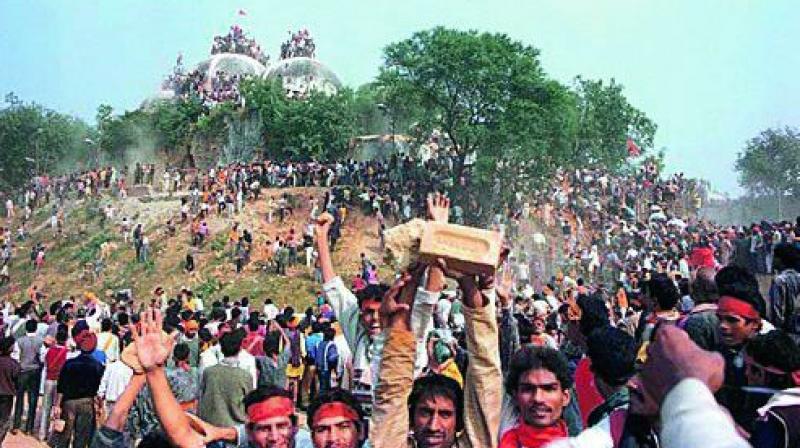360 degree: Ayodhya's appeal lay dormant in BJP psyche

The sheer magnitude of the BJP’s stunning victory in the Uttar Pradesh Assembly polls signalled the end of the political exile of the party in the state. It also signals a strong resurgence of the latent Hindutva sentiment on which the Bharatiya Janata Party had so proudly pegged itself from the late 1980s. The victory has once again catapulted the BJP to the top position in UP which it enjoyed from the days of the Ram Janambhoomi movement in the early 1990s.
The movement had focused on the perception of setting right alleged historical wrongs, which manifested itself in the demand that a magnificent temple dedicated to Lord Rama be built at Ayodhya. The saffron brigade claimed that a temple existed on the spot which was demolished on the orders of the first Mughal emperor, Babur, who then got the Babri mosque constructed at the spot. Even as historians were sceptical, the movement gained strength.
But it was the announcement of the implementation of the Mandal commission recommendations and thereby, reservations for other backward classes by the V.P. Singh government at the Centre in August 1990 that put the movement on the fast-track. The BJP, rattled by the move, decided to focus on Hindutva politics by pitting the “kamandal” (a vessel used by Hindu seers and also for performance of Hindu rituals) to counter “Mandal”. When BJP leader L.K. Advani began a highly controversial rath yatra from Somnath to Ayodhya in September 1990, it changed politics in the Hindi heartland forever for the second time in a year. The political consequences of this were far-reaching. “Mandalite” leaders such as Lalu Prasad Yadav and Mulayam Singh Yadav, who hailed from the numerically significant Yadav clan — one of the major beneficiaries of reservations for OBCs — became “secular” messiahs and heroes for the Muslim community for opposing Hindutva politics. They tagged their own communities politically along with Muslims to form a formidable electoral “MY” (Muslim-Yadav) combination.
Also Read: 25 years later, Babri returns to haunt us...
From the BJP, it thrust Mr Advani into the limelight and gave him political credit for “saving” the party from the onslaught of Mandal. Within months of the V.P. Singh government falling in November 1990, the BJP rode the “Ram mandir” wave to come to power for the first time in Uttar Pradesh on its own in June 1991, clocking 221 out of the then 425 seats (that included Uttarakhand) in the UP Assembly. There were two other BJP leaders — both from the OBC Lodh community — in the Hindi heartland who shot into limelight. One was Kalyan Singh, who became the chief minister in UP’s first BJP government in 1991. The second was Uma Bharti from Bundelkhand region of Madhya Pradesh, who was a prominent participant in the Ayodhya movement. Due to the rise of these two leaders, the BJP successfully experimented with social engineering by forging a coalition of their traditional vote bank, the upper castes, with the non-Yadav OBCs — a conglomeration of smaller OBC communities — that began voting for the BJP.
Toward the end of 1992 in November, the Supreme Court upheld the implementation of the Mandal report. Around that time, the Ayodhya stir was once again intensifying and this time the pressure was on the BJP since it was in government in UP. The stir culminated in the unfortunate and tragic demolition of the Babri Masjid by Hindutva “kar sevaks” on December 6, 1992, which resulted in the dismissal of Kalyan Singh’s government in UP and also three other BJP state governments. But nevertheless, the Ayodhya sentiment propelled the party’s nation-wide rise, which saw the BJP coming to power at the Centre in the late 1990s under Atal Bihari Vajpayee, viewed as a moderate who could pull in alliance partners since the BJP could not muster a majority on its own.
In other developments, the mid and late 1990s saw fierce triangular electoral contests in UP between the BJP, Samajwadi Party and the Bahujan Samaj Party, with the BJP having the electoral upperhand due to split in Muslim vote and its strong Hindutva image and majoritarian appeal, which partially overrode the caste factor. But things changed in 1999 when BJP stalwart and then UP CM Kalyan Singh was expelled from the party. Soon, non-Yadav OBCs stopped voting for the BJP largely and switched over to the SP, triggering the collapse of the BJP in UP and reducing subsequent electoral contests to a two-horse race in UP between the SP and BSP. With the matter pending in courts, the appeal of the Ayodhya movement also considerably faded by then. The BJP also lost power at the Centre in 2004.
Also Read: ‘I was a kar sevak before Masjid was demolished’
But things changed in 2013 when the BJP’s then prime ministerial candidate Narendra Modi began his blitzkrieg across UP in the run-up to the 2014 Lok Sabha polls. Curiously, then the BJP focused on the issue of development and not Hindutva, but Mr Modi’s strong Hindutva image always meant that the BJP in reality continued to limit itself to its majoritarian appeal. But the Ayodhya appeal still lay embedded in the BJP psyche and those of its supporters, with Prime Minister Modi himself addressing a rally in Faizabad where Lord Rama’s poster happened to be in the background.
The BJP-led alliance swept 73 out of the 80 seats in the LS polls. But the real test for the BJP’s revival still lay in the UP Assembly polls of 2017. On his campaign blitzkrieg once again, Mr Modi straddled his message of development with the powerful symbolism of visiting the Kashi Vishwanath temple in Varanasi before the polls. It’s a test that the BJP Saturday passed with flying colours. When all parties swear by the development mantra, the Ayodhya movement may not get limelight again. But the political and social consequences the stir unleashed are there for all to see.

